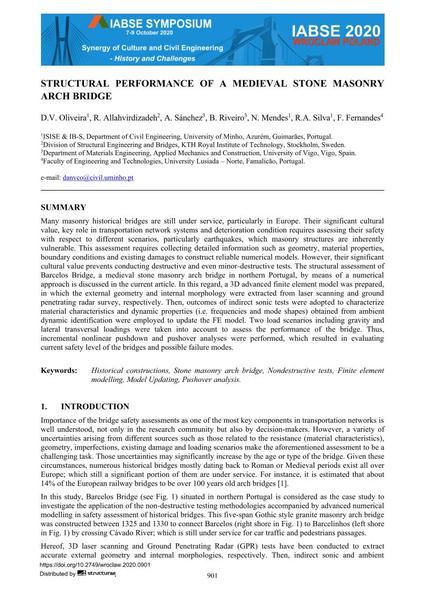Structural Performance of a Medieval Stone Masonry Arch Bridge

|
|
|||||||||||
Bibliographic Details
| Author(s): |
D. V. Oliveira
R. Allahvirdizadeh A. Sánchez B. Riveiro N. Mendes R. A. Silva F. Fernandes |
||||
|---|---|---|---|---|---|
| Medium: | conference paper | ||||
| Language(s): | English | ||||
| Conference: | IABSE Symposium: Synergy of Culture and Civil Engineering – History and Challenges, Wrocław, Poland, 7-9 October 2020 | ||||
| Published in: | IABSE Symposium Wroclaw 2020 | ||||
|
|||||
| Page(s): | 901-908 | ||||
| Total no. of pages: | 8 | ||||
| Year: | 2020 | ||||
| DOI: | 10.2749/wroclaw.2020.0901 | ||||
| Abstract: |
Many masonry historical bridges are still under service, particularly in Europe. Their significant cultural value, key role in transportation network systems and deterioration condition requires assessing their safety with respect to different scenarios, particularly earthquakes, which masonry structures are inherently vulnerable. This assessment requires collecting detailed information such as geometry, material properties, boundary conditions and existing damages to construct reliable numerical models. However, their significant cultural value prevents conducting destructive and even minor-destructive tests. The structural assessment of Barcelos Bridge, a medieval stone masonry arch bridge in northern Portugal, by means of a numerical approach is discussed in the current article. In this regard, a 3D advanced finite element model was prepared, in which the external geometry and internal morphology were extracted from laser scanning and ground penetrating radar survey, respectively. Then, outcomes of indirect sonic tests were adopted to characterize material characteristics and dynamic properties (i.e. frequencies and mode shapes) obtained from ambient dynamic identification were employed to update the FE model. Two load scenarios including gravity and lateral transversal loadings were taken into account to assess the performance of the bridge. Thus, incremental nonlinear pushdown and pushover analyses were performed, which resulted in evaluating current safety level of the bridges and possible failure modes. |
||||
| Keywords: |
model updating pushover analysis historical constructions finite element modelling Stone masonry arch bridge Nondestructive tests
|
||||
